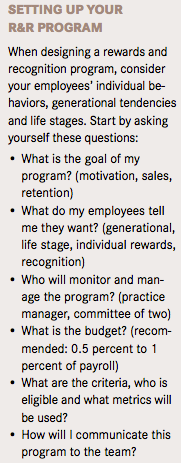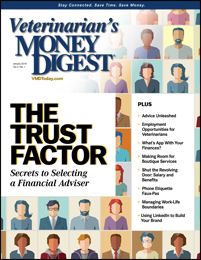Shut the Revolving Door - Part 2: Salary and Benefits
A competitive compensation package that includes appealing incentives can help attract and retain elite talent.

Taking a proactive approach to the employee-related aspects of your business is crucial to overall veterinary practice success. By anticipating staff needs and safeguarding your practice against unforeseen events, you’ll protect yourself from the pitfalls of practice management blunders.
Part one of this four-part series focused on regularly updating job descriptions and assessing employee skills gaps. To create a well-rounded and productive team, you must make sure everyone has a clear understanding of their roles and expectations. Routine performance reviews will shed light on gaps within current staff — a lack of knowledge, skill or practice — and roles that may require new talent.

Following the initial stage of talentacquisition, the next phase of hiring and retaining employees encompasses compensation, benefits and rewards. Covering these topics in an initial interview typically results in an awkward exchange: The candidate wants to know what the hourly wage will be while the hiring manager attempts to test the waters of salary expectations. But do not wait until the day of an interview to decide the details. It’s important that managers have a clear understanding of compensation packages and are comfortable relaying to prospective employees what the practice has to offer.
Compensation and Benefits
How do your pay scale and benefits compare with those of other practices in your local market? Compensation and benefits play a vital role in attracting and keeping quality employees, so deciding on these components should not be left to the last minute. Ignoring trends and failing to update policies will antiquate an otherwise promising veterinary practice.
Just as job descriptions need continual review, compensation analyses should be conducted regularly. Although resources such as the American Animal Hospital Association and the Veterinary Hospital Managers Association compensation surveys can help, you will want to evaluate wage information from your immediate area, as well. Check the Bureau of Labor Statistics website, online job boards and competitors’ websites for supplementary information.
Other factors to consider include rewards for bringing in new clients, flexibility for individual needs, and rewarding additional credentials and work experience that increase knowledge and skills.
Of course, employee compensation is about more than the hourly pay rate. Numerous benefits can be added into the mix to create a package that is attractive, competitive and financially sound (see Possible Benefit Offerings).

Before implementing benefits, consult an accountant to determine related tax issues and ensure equitable options. Keep in mind that all employees do not have to receive the exact same perks — flexible options of equivalent value are attractive to today’s workforce.
The key issue is how these options can aid your recruitment efforts, ensure your practice stands out in the marketplace, improve retention and acknowledge what your employees value.
Rewards and Recognition
When assessing how to retain key talent, consider the status of your current rewards and recognition (R&R) program. Don’t have one? It’s worth setting up. A well-orchestrated R&R program can:
- Increase employee engagement
- Improve productivity and profitability
- Improve client service
- Improve your ability to attract and retain employees
- Build your brand and employee loyalty
- Demonstrate the practice culture to employees
- Improve the performance review process
- Drive behavioral change
- Facilitate the implementation of change in management projects
- Reduce stress, absenteeism and turnover
- Enhance the learning and development of personnel
Given these benefits, what is stopping you from developing your R&R program? To make yours work, consider these three rules:
- There is no one-size-fits-all approach to rewards and recognition.
- R&R should be valued and desired by employees.
- There is inherent complexity in generalizing any one group.
Take, for example, the baby-boom generation (ages 51 to 70). Suggested R&R programs for this age group focus on health care, retirement benefits and promotions with titles. However, refer to rule one: Some baby boomers have no plans to retire; others want to retire as soon as they can.
Generation Xers (ages 35 to 50) may or may not be in the throes of paying a mortgage and raising a family. Not every Gen Xer can contribute to a retirement plan. The millennial generation (ages 16 to 34) generally desires recognition, flex work, autonomy and being involved in heading up projects. And let’s not forget BYOD — bring your own device.

Generational differences should not be the only factor in determining what rewards to offer or how to deliver recognition. Life stages also come into play. Consider employees who are expectant parents, raising young children or responsible for elder care. Odds are you can think of a millennial who provides care for an elderly parent or grandparent, or a baby boomer who is raising a grandchild.
To create an R&R program that satisfies everyone, you will want to analyze your workforce and understand individual behaviors, generational tendencies and life stages. The wide array of choices can quickly seem overwhelming, so approach the process with a strategy in mind (see Setting Up Your R&R Program).
To give your employees some control over the R&R offerings, start by surveying them to get ideas. (Survey Monkey offers a simple template that can also help you develop relevant questions.) You might be surprised to learn that everyone wants flexible work hours, maybe just not for the same reasons, and some might like time off for volunteering. Sabbaticals are considered important to baby boomers and millennials, while mentorship time is higher on the Gen X list. You can create your own plan or tap into the services of an outside source to help establish and manage a program.
What's in It for You?
How do you benefit when you adjust your compensation and benefits and R&R programs to fit your employees’ needs and desires? You maintain a competitive edge for attracting new talent and retaining current talent. Handing out across-the-board percentage increases to every employee each year can get old. Soon, those who are building their knowledge and skills, or making the extra effort, will lose motivation and look for greener pastures.
Engaging new hires means you must market yourself, and that includes your business, brand and benefits. Savvy business managers use current compensation and benefit information to ensure their practices appeal to new talent. Attracting and retaining talent involves more than the amount of an hourly wage. Other benefits and reward programs also play a role in remaining competitive in the talent game. Ignoring trends opens the door for poaching of your key talent by businesses that monitor the trends and adjust their offerings.
Ms. Dunn is an award-winning speaker, writer and consultant who brings over 40 years of in-the-trenches experience and business education to veterinary management. She is founder and CEO of Snowgoose Veterinary Management Consulting, which helps veterinarians develop strategic plans that consistently produce results.
